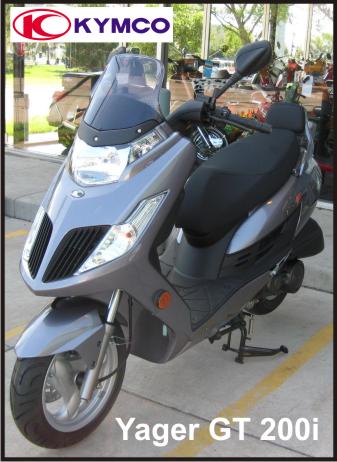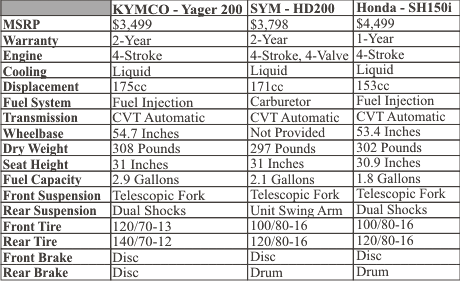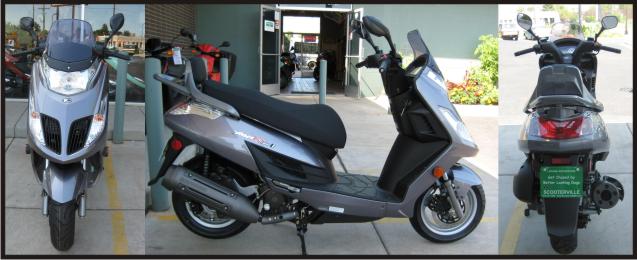The scooter as outstanding modern urban transport. That’s a subject I have been known to go on and on and on about. Here in the USA, we have been slower than other countries in the world to adopt scooters as viable urban transport. In speaking with a fair number of regular commuters, I suspect this is because scooters tend to be viewed in the USA as small, cute, toys that don’t really have the speed to deal with the modern commute. Of course there are many “maxi” scooters (Burgman, Silverwing, Xciting, Majesty, etc.) that are large and have powerful engines, but they are often viewed as something more akin to automatic motorcycles. Perhaps what the USA commuter needs is a medium sized scooter, with enough power for highway use that is still light enough to feel comfortable around town. Maybe those commuters want a liquid-cooled engine and fuel injection. I shouldn’t be at all surprised to find that copious storage is an important feature.
Those commuters need to have a look at the Kymco Yager GT200i.
Speedometer Reading/Speed/Fuel Economy
Right after “What does it cost?” ($3,499) the most commonly asked questions involve top speed and fuel economy.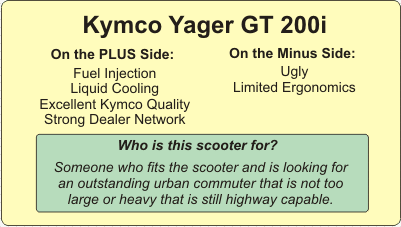
The top speed was 71 MPH and fuel economy was 76 MPG. This scooter was new and the engine was NOT broken in. As such, I wasn’t overly harsh with it. I expect that after break-in, the top speed may go up a bit and fuel economy will likely be about 75 MPG at highway speeds and something like 80 MPG at city speeds. I consider this to be very good fuel economy considering the capabilities of this scooter.
Features
The Kymco Yager GT 200i… OK, I have to stop here for a moment. Before I tell you about this scooter I just have to put my two cents out there about the name. For starters, the graphics make the name look more like “Ager” than Yager, and just what is this supposed to mean? It’s close to the German for “hunter” (der jager), but that’s about all I could come up with. As to the “200” in the name, the Yager’s engine is 175cc, so why not call it a 180? SYM does the same thing with the HD200. It’s 171cc, and a fine machine, but why call it a 200? Both Kymco and SYM, two excellent Taiwanese brands, need to take a page from the Genuine Scooter book and give more thought to the US marketplace when naming their products. Right. Back to the scooter.
The Yager is a modern, liquid-cooled, fuel-injected, four-stroke, automatic scooter. I chose to compare it with the SYM HD 200 and the Honda SH150i. All three are liquid-cooled and of modern design. The Kymco and the Honda are fuel-injected while the SYM utilizes a carburetor.
Looking at the specifications we notice that the Kymco is the heaviest and has the smallest wheels. It is also the least expensive and utilizes disk brakes front AND rear while the SYM and Honda have a drum in the back. A little later on in this review, we’ll have more of a side-by-side between the Kymco and the SYM. I consider the Honda, at $1,000 more expensive than the Kymco, overpriced and did not attempt to track down one for direct comparison. All three of these scooters were designed for the urban commuter. They are all capable of highway speeds while being light and agile enough to handle city riding with ease.
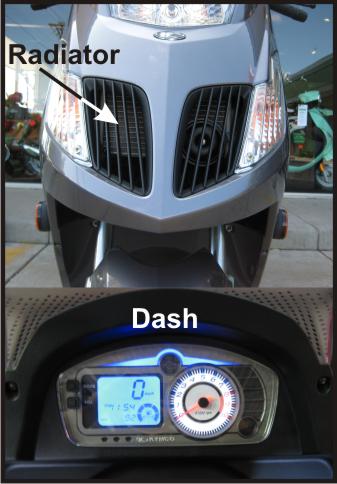
The dash is an interesting mix of digital and analog. Starting on the right side of the dash, there is a slightly curved row of indicator and warning lights. Next to that is a round analog tachometer. This is easy to read at a glance and about two steps from useless on a modern twist-and-go automatic scooter. Next to the tach is a rectangular digital pod that houses the speedometer, fuel gauge, clock, tip-meter and odometer. As mentioned earlier, the speedometer is astoundingly accurate. The fuel gauge is semi-circular and made up of four sections. Each section disappears as fuel is consumed in quarter-tank increments. The odometer and speedometer can be easily switched between displays in miles and in kilometers. I found the digital pod bright and easy to read. I only had to get the owner’s manual out to set the clock, the miles/kilometers function and trip functions were simple and intuitive.
Lighting on the Kymco Yager was good. I could see well enough when riding at night, and the brake lights and turn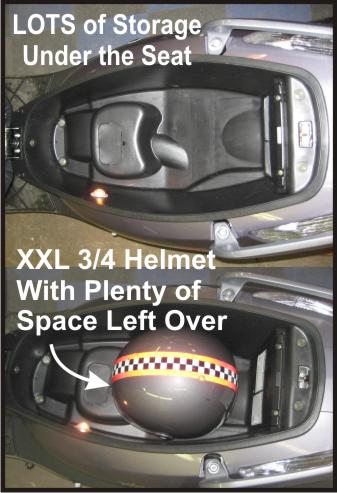
The under-seat storage space on the Yager is exceptional. There was plenty of room for my extra-extra-large three-quarter helmet. My full-face even fit with room to spare. With just a little squishing, I managed to get my messenger bag under the seat – something I usually can NOT do with most scooters. There is a small back-rest for the passenger that is integrated with grab rails and a small and severely tilted luggage rack. It’s my guess that one will have to have some kind of adapter to effectively mount a topcase on the Yager. You may well not need one with all the space under the seat. The passenger is also treated to “switchblade” foot-rests. One pushes buttons near the rests and they spring out and into position. Yeah, I know, but it IS pretty cool.
As one would expect from a Kymco, everything worked flawlessly. The quality of the components is obvious after living with them for a bit. Switches engage easily and have a very solid “feel” to them.
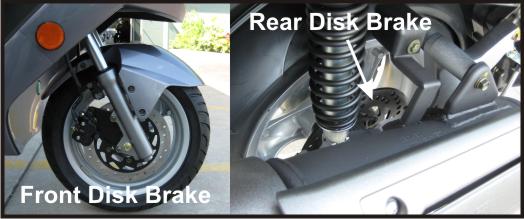
Riding Impressions
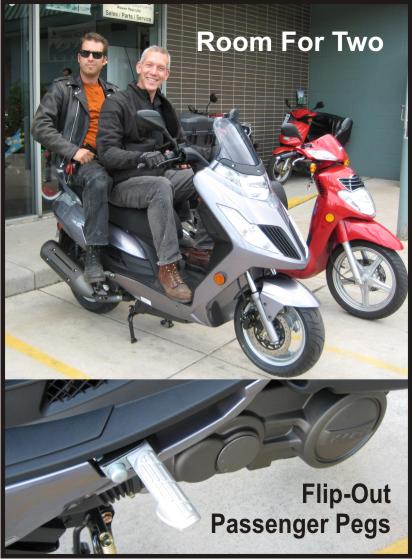
The brakes were wonderful. The front and rear disk combination made for firm, no-fade stops that were very easy to modulate. The brakes operate independently, no linked braking on the Yager. Linked brakes (one control operating both the front and rear) are a nice feature for new riders, but as an experienced rider I prefer the control of independent operation. The suspension was a touch on the soft side for my taste, but I felt that the handling and ride were very good overall. The seat was very firm, which I like. Others thought the seat was too firm and uncomfortable as a result. The relative positioning of the controls (handlebars) is a touch on the low side. Not nearly as low as the Kymco Grand Vista, but lower than most other scooters in this class. The floorboards are flat and the seat is about 31 inches from the ground. This SHOULD combine into pretty tough ergonomics, but it doesn’t. At 5′ 9″ I was very comfortable. Other riders up to 6′ 2″ were able to find a good seating position. Riders shorter than 5′ 6″ had some trouble at stops with the tall seat, but were just fine when riding. I would say that the “sweet spot” ergonomically is to be found for people between 5′ 8″ and 6′.
Kymco vs. SYM
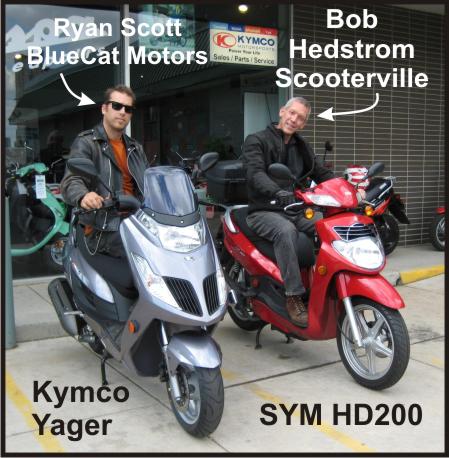
Ryan Scott found the handle bar on the Kymco was a bit too low for him and he thought the seat was too hard and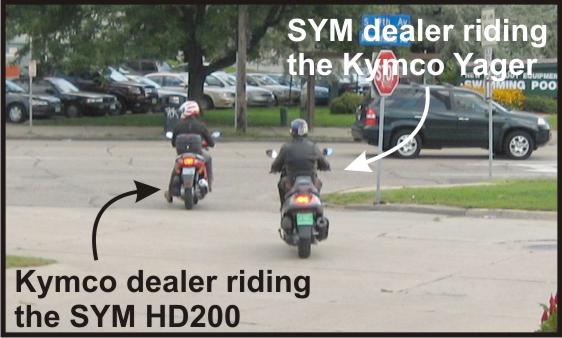
Bob Hedstrom’s response when I asked for his comments on the SYM HD200 was “What’s not to like.” He thought the SYM was a very strong runner, had excellent handling and was fun to ride. Bob is over 6′ and he found the step seat on the SYM uncomfortable.
I have ridden both scooters a fair amount and would be hard pressed to name a clear “winner” between the two of them. The SYM HD200 is both quicker (off the line) and faster (top speed) than the Kymco Yager. The SYM has bigger wheels front and rear and a more stable high-speed ride as a result. The Kymco Yager has better brakes that the SYM and is smoother running. It also has more storage space. Both are liquid-cooled, but the Kymco Yager is also fuel-injected while the SYM HD200 utilizes a carburetor. Protection from wind, rain, and road grime is also better on the Kymco. The SYM is $300 more expensive than the Kymco. With fuel injection and a rear disk brake at a lower price, the Kymco is a slightly better value. That being said, $300 isn’t much of a difference and the bigger wheels of the SYM are better suited to a rider who will spend more time on the highway than around town. I would strongly suggest that a potential purchaser look at BOTH scooters and purchase the one that fits you and your needs the best.
Fit and Finish
The Taiwanese scooter manufacturers generally do an excellent job when it comes to fit and finish. Kymco and SYM are the cream of the crop with PGO (Genuine) and TGB right up there as well. I would put a Kymco or SYM scooter up against anything out of Japan (Honda, Yamaha, Suzuki) so far as fit and finish is concerned. The care that goes into engineering and manufacturing these machines is obvious. I assisted in pre-delivery of the Kymco Yager used in this review. One of the tasks was to install the windscreen and lower trim bezel. Anyone who has had to do this on other scooter knows it can be a difficult task. Even more expensive brands (cough, cough, Piaggio, cough) struggle in this area. Alignment, fasteners, quality control – all can, and often are, issues when putting the finishing touches on a scooter. The Kymco Yager windscreen fit perfectly, aligned with precision, and fastened easily and securely. From the paint work to the individual components, fit and finish on the Kymco Yager is very good.
Conclusions
Forget the lame name, the ugly front end and the erroneous “200” – The Kymco GT 200i is a wonderful choice if you want a true “do everything” urban commuter. Kymco has a large (and growing) dealer base, so finding one and getting service should be no problem. If it fits you physically, you will have a machine with rugged, reliable, modern technology that is great fun to ride. At $3,499 it’s also an outstanding value.


